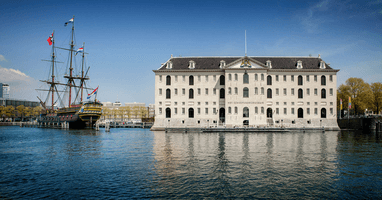

The National Maritime Museum is housed in the Arsenal. This important historic building dates from 1656 and was designed y Daniel Stalpaert as a warehouse for the Admiralty of Amsterdam. It was built during the Golden Age, when Amsterdam was the largest port and trading post in the world. Goods from all over the globe could be bought right at this very spot. Today, more than 350 years later, the Zeemagazijn remains an imposing and impressive building, whose white sandstone exterior contrasts with the red brick and more somber colors prevalent in most of the historic Amsterdam structures. The building breathes history, and that made it a perfect location for The National Maritime Museum which has been housed here since 1973.
In the end of 16th century Amsterdam experienced a period of explosive growth. In 1650, the city council had drawn plans for three new islands destined for shipyards, warehouses and homes. The Admiralty of Amsterdam shipyard and its adjacent warehouse, the Zeemagazijn, were built on the island of Kattenburg. Opened in the middle of 17th century, the building contained cannons, sails, flags and sails for the war fleet. Its vaulted cellars under the inner courtyard were used to collect and store rainwater - some 40,000 liters - that provided drinking water for the ships.
The building is still supported by more than 2 thousands wooden piles driven into the mud that prevent it from sinking. The buttresses (the angled "feet" under the building) and extra ressaults (the exterior extensions) have been added for support and to prevent the risk of collapse. In 1791, the entire interior of the building was destroyed by fire, and only the outer stone shell was left untouched. It was then that the charred brickwork was covered with a layer of plaster, thus producing the appearance of gracious blocks of sandstone.
When Napoleon occupied the country and established the Batavian Republic, the five Admiralties were abolished and replaced by a national navy. As a result, the Zeemagazijn became a storehouse for the navy and remained so until the early 1970s. In 1972, it was decided that the building would house the National Maritime Museum collection. On April 13th 1973, the museum was officially opened by Princess Beatrix.
In 2007, the museum underwent a much needed major and complicated, due to the buildings long history, renovation. Perhaps the high point, both literally and figuratively, was the installation of the giant glass roof over the inner courtyard. Its self-supporting construction is made up of thousands of pieces of glass encased in a metal frame.
The ship moored at the back of the Scheepsvaartmuseum is a replica of a Dutch East India Company ship called Amsterdam. It was an 18th-century cargo ship that started its maiden voyage from the island of Texel to Batavia (todays Jakarta) on January 8th, 1749, but was wrecked in a storm in the English Channel on January 26th, 1749. The shipwreck was discovered in 1969 in the bay of Bulverhythe, United Kingdom, since it is sometimes visible during low tides. Since 1974, the wreck site is protected under the UK Protection of Wrecks.
Using the tools of the era, between 1985 and 1990, 400 volunteers built this replica of Amsterdam in Iroko wood in Lelystad. As for the original ship, in the 1980s there were hopes that the Dutch Government, which still owns it, might excavate the wreck and return it to Amsterdam, but the funds were withheld. Several decks and much of the bowsprit lie submerged in the mud and, being naturally preserved by the mud, are in a remarkably good condition, with most of the cargo still onboard.